 IST,
IST,
II. Fiscal Situation
Combined Government Finances in 2005-06
The combined gross fiscal deficit (GFD) of the Centre and States is budgeted to decline to 7.6 per cent of GDP in 2005-06 from 8.3 per cent of GDP in the revised estimates (RE) for 2004-05. The combined gross primary deficit (PD) and revenue deficit (RD) are also budgeted to decline to 1.7 per cent and 3.4 per cent of GDP, respectively, from 2.3 per cent and 4.1 per cent in 2004-05(RE). The reduction in the deficits is sought to be achieved primarily through higher revenue mobilisation, especially under direct taxes. A notable feature on the expenditure side is emphasis on developmental expenditure.
Centre's Fiscal Situation
The Union Budget 2005-06 projected the revenue deficit and gross fiscal deficit at 2.7 per cent and 4.3 per cent of GDP, respectively. While making a provision for higher resource devolution to the States in accordance with the recommendations of the Twelfth Finance Commission (TFC), for compensation of any revenue loss associated with implementing State-level VAT and by discontinuing the practice of treating disinvestment proceeds as a budgetary receipt from the year 2005-06, the Centre committed to revert to the Fiscal Responsibility and Budget Management (FRBM) path from 2006-07 so as to achieve the targets set for 2008-09.
Available information for the first two months (April-May) of 2005-06 on Central Government finances indicates a buoyant collection in customs duties and a moderation in the typical beginning-of-the-year tax refunds which resulted in an improvement in revenue receipts as a ratio of the budget estimates (Table 10). Non-tax revenue (as a proportion to the budget estimates) was at the same level as in the first two months of the preceding fiscal year. Aggregate expenditure declined during April-May 2005, mainly on account of lower defence outlay and subsidies. Accordingly, the revenue deficit and the primary deficit as proportion to budget estimates during April-May 2005 were placed lower than their levels a year ago. The fiscal deficit, on the other hand, was higher (as a proportion to budget estimates) mainly on account of lower non-debt capital receipts with the discontinuance of the debt swap scheme from 2005-06.
State Finances - 2005-061
The State Budgets for 2005-06 placed emphasis on fiscal consolidation through curtailment of expenditure by modifying policies on issues such as providing free power and implementing contributory pension funds to lessen large pension
1 Based on information pertaining to 27 State Budgets of which three are Vote-on-Accounts Budgets.
|
Table 10: Central Government Finances during April-May 2005 |
||||||
|
(Rs. Crore) |
||||||
|
Items |
2005-06 |
April-May |
Per cent of Budget Estimates |
|||
|
(Budget |
2005 |
|||||
|
April-May |
April-May |
|||||
|
Estimates) |
||||||
|
2004 |
2005 |
|||||
|
1 |
2 |
3 |
4 |
5 |
||
|
1. |
Revenue Receipts (i+ii) |
3,51,200 |
11,944 |
2.6 |
3.4 |
|
|
i) |
Tax Revenue |
2,73,466 |
8,659 |
2.0 |
3.2 |
|
|
ii) |
Non-tax Revenue |
77,734 |
3,285 |
4.2 |
4.2 |
|
|
2. |
Non-debt Capital Receipts |
12,000 |
190 |
43.3 |
1.6 |
|
|
3. |
Non-Plan Expenditure |
3,70,847 |
46,788 |
14.1 |
12.6 |
|
|
of which: |
||||||
|
i) |
Interest Payments |
1,33,945 |
21,167 |
15.3 |
15.8 |
|
|
ii) |
Defence |
83,000 |
4,751 |
9.5 |
5.7 |
|
|
iii) |
Subsidies |
46,358 |
7,196 |
20.8 |
15.5 |
|
|
4. |
Plan Expenditure |
1,43,497 |
12,949 |
9.3 |
9.0 |
|
|
5. |
Revenue Expenditure |
4,46,512 |
56,098 |
13.4 |
12.6 |
|
|
6. |
Capital Expenditure |
67,832 |
3,639 |
9.4 |
5.4 |
|
|
7. |
Total Expenditure |
5,14,344 |
59,737 |
12.6 |
11.6 |
|
|
8. |
Revenue Deficit |
95,312 |
44,154 |
57.5 |
46.3 |
|
|
(2.7) |
||||||
|
9. |
Gross Fiscal Deficit |
1,51,144 |
47,603 |
28.4 |
31.5 |
|
|
(4.3) |
||||||
|
10.Gross Primary Deficit |
17,199 |
26,436 |
241.8 |
153.7 |
||
|
(0.5) |
||||||
|
Note :Figures in parentheses are per cent to GDP. |
||||||
obligations. The TFC has incentivised the enactment of Fiscal Responsibility Legislation (FRL) by the States by making it a pre-condition for availing debt relief. While eleven States have enacted FRL, three have already presented their FRL Bill in 2005-06. Three more States have proposed to legislate such Bills during the year and one State has promulgated an ordinance in this regard. The ratio of primary deficit to GDP is budgeted to decline by 0.7 percentage points to 0.4 per cent while the RD/GDP ratio is budgeted to halve to 0.7 per cent. Consequently, the GFD/GDP ratio is also budgeted to decline by 0.8 percentage points to 3.0 per cent (Chart 6).
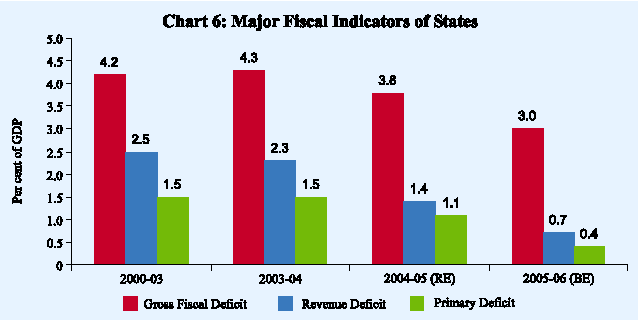
The fiscal correction in State finances is sought to be achieved primarily through reduction in non-interest revenue expenditure. Almost all the major components of expenditure are budgeted to register lower growth.
Financing Pattern
The financing pattern of the combined GFD of the Centre and the States for 2005-06 indicates a sharp increase in market borrowings while the recourse to the other sources of finance is expected to decline. Accordingly, market borrowings are budgeted to finance 45.1 per cent of the combined GFD during 2005-06 as compared with 30.4 per cent during 2004-05 (Chart 7).
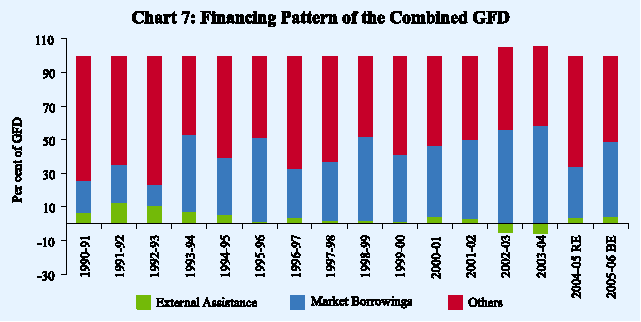
Financing of the Union Budget
Net market borrowings (excluding allocations under MSS) are budgeted at Rs. 1,03,791 crore, financing 68.7 per cent of the GFD in 2005-06 as compared with 33.0 per cent in the previous year. Including repayment obligations of Rs.61,676 crore, gross market borrowings of the Central Government work out to Rs. 1,65,467 crore. Draw down of surplus cash balances with the Reserve Bank would finance 2.1 per cent of the GFD as against 15.1 per cent in 2004-05 (RE). Investments made by the National Small Savings Fund (NSSF) out of debt swap transactions in the securities against small savings, which financed 24.4 per cent of the GFD in 2004-05, are expected to finance only 2.0 per cent of GFD in 2005-06 with the discontinuation of the debt swap scheme.
During Q1 of 2005-06, the actual issuances of dated securities amounted to Rs.42,000 crore as against Rs. 44,000 crore scheduled in the calendar for Q1 of 2005-06 (Table 11). This was on account of a reduction in the notified amount from Rs.4,000 crore (as per the issuance auction calendar) to Rs.2,000 crore for maturity of 29.27 years in the auction of May 3, 2005. Gross and net market borrowings raised by the Centre amounted to 29.7 per cent and 30.9 per cent of the budget estimates as compared with 23.2 per cent and 5.2 per cent, respectively, a year ago.
|
Table 11: Central Government Securities Issued in the First Quarter of 2005-06 |
|||
|
Date of Auction |
Notified Amount (Rs. crore) |
Residual Maturity (Years) |
Cut-off Yield (Per cent) |
|
1 |
2 |
3 |
4 |
|
April 5, 2005 |
5,000 |
6.98 |
6.80 |
|
April 5, 2005 |
3,000 |
27.39 |
7.79 |
|
April 19, 2005 |
5,000 |
11.74 |
7.48 |
|
April 19, 2005 |
2,000 |
29.31 |
7.94 |
|
May 3, 2005 |
6,000 |
5.03 |
6.99 |
|
May 3, 2005 |
2,000 |
29.27 |
7.98 |
|
May 24, 2005 |
4,000 |
16.05 |
7.28 |
|
June 6, 2005 |
4,000 |
15.98 |
7.47 |
|
June 6, 2005 |
6,000 |
8.86 |
6.91 |
|
June 23, 2005 |
5,000 |
10.81 |
6.91 |
The Centre's Ways and Means Advances (WMA) limits from the Reserve Bank continued to be fixed at Rs.10,000 crore in the first half (April-September) and Rs.6,000 crore in the second half (October-March) of 2005-06. Reflecting its comfortable liquidity position, the Centre availed WMA only twice (May 3 and
June 4, 2005) during Q1, 2005-06. The Centre has maintained higher surplus cash balances with the Reserve Bank in Q1 of 2005-06 than in the corresponding period of 2004-05 (Chart 8).
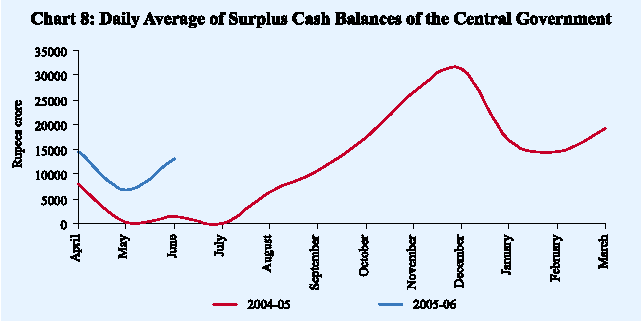
During Q1, 2005-06 the weighted average maturity of dated securities of the
Central Government was lower at 13.30 years than 16.07 years in the corresponding period of the preceding year. On the other hand, the weighted average yield of the dated securities increased to 7.23 per cent from 5.54 percent during Q1, 2004-05 reflecting the current upturn in interest rates (Chart 9).
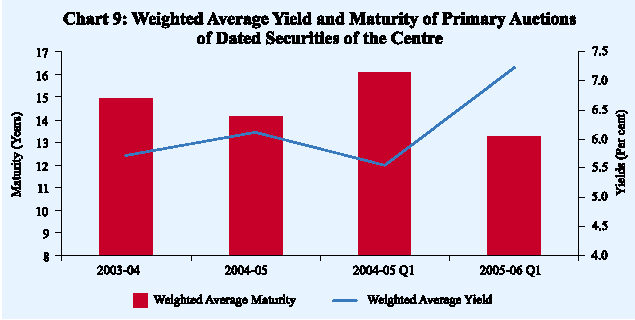
Financing of the States' Budgets
The provisional net allocation under the market borrowing programme for State Governments is placed at Rs.16,112 crore during 2005-06. Taking into account the repayments of Rs.6,274 crore and additional borrowing allocation of Rs.290 crore, the gross allocation amounts to Rs.22,676 crore.
During Q1, 2005-06 States raised an amount of Rs.10,245 crore (Rs.7,554 crore
through tap sale and Rs.2,691 crore though auctions). The weighted average interest rate of market loans during Q1, 2005-06 firmed up to 7.67 per cent from 5.65 per cent in Q1, 2004-05 (Chart 10).
States have generally not taken into account the recommendations of the TFC. Reckoning the net Central loans for State Plans as reported in the Union Budget 2005-06 and assuming that the State Plans are maintained at the budgeted level, the market borrowings during 2005-06 would not be substantially higher than the provisional net allocation amount on account of higher devolution of taxes and grants and larger receipts from the NSSF.
The weekly average utilisation of WMA and overdraft by the States during Q1, 2005-06 amounted to Rs.1,449 crore, which was significantly lower than that
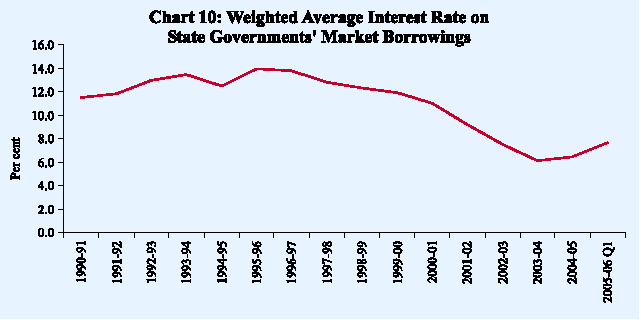
of Rs.3,720 crore in the corresponding period of the previous year (Chart 11).Nine States resorted to overdraft during Q1, 2005-06 as compared with 11 States during the correrponding period of the previous year.
Public Debt
The combined debt-GDP ratio of the Centre and the States is estimated to register a moderate decline to 81.0 per cent by March 2006 (BE) from 81.8 per cent in March 2005 (RE) (Chart 12).of Rs.3,720 crore in the corresponding period of the previous year (Chart 11).
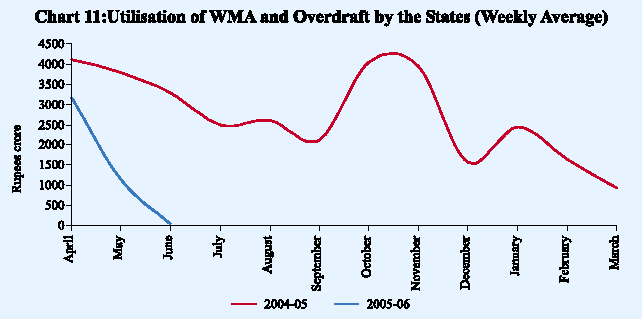
Public Debt
The combined debt-GDP ratio of the Centre and the States is estimated to register a moderate decline to 81.0 per cent by March 2006 (BE) from 81.8 per cent in March 2005 (RE) (Chart 12).
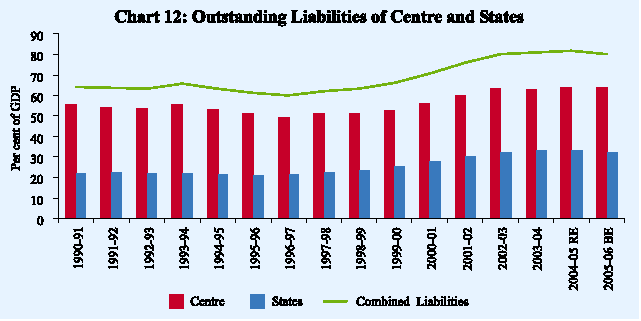
Outlook
Fiscal policy for 2005-06 aims to build a spirit of cooperative federalism by enhanced devolution of resources for the State Governments from the Centre and support their endeavour to implement the State-level VAT. The cornerstone of the fiscal strategy is to persist with tax reforms for realising higher revenue collections while simultaneously undertaking expenditure management with an emphasis on delivery mechanisms so that 'outlays' are translated into 'outcomes'.
The TFC recommendation of a substantial increase in devolution and transfers to the States should help ease the pressure on their budgets. At the same time, the TFC has improved the conditions for enactment of fiscal responsibility legislation by the States as well as for fiscal discipline and more realistic State Plan outlays. The States would accordingly need to formulate concrete and transparent strategies to attain these goals. Against this backdrop, the State Budgets for 2005-06 envisage substantial fiscal correction from the levels in the previous years.
Page Last Updated on:

















